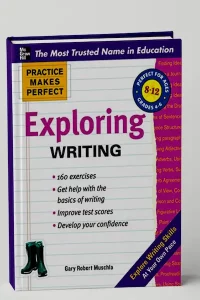Practice Makes Perfect Exploring Writing is a great book to improve your basic writing and also to develop your confidence with 170 exercises about basic writing.
About This Book
Learning to write is a challenging, multiskilled process. Students must learn how to identify, analyze, and develop ideas. They must learn how to compose sentences, build paragraphs, and express ideas within the standards of written English. They must discover their “voice” and learn how to precisely say what they want with fluency, clarity, and energy.
Practice Makes Perfect: Exploring Writing can be a valuable resource for developing writing skills. It can be used by both students and teachers. Students (working alone or with their parents) can work through the exercises and worksheets to improve their writing, while teachers will find the materials of the book to be useful for classroom instruction or to supplement their writing program.
The teaching exercises and worksheets provide students with meaningful writing assignments and activities. They will learn how to find and focus ideas for writing, how to write a draft, how to revise their writing, and how to proofread their work. This book, which is based on the stages of the writing process, will give students the practice they need to acquire the skills for effective composition and to grow as young writers.
Learning to write is a difficult task. It is my hope that you will find this book useful in that demanding and rewarding challenge.
Practice Makes Perfect Exploring Writing
Helpful instruction and plenty of practice for your child to understand the basics of writing…
Understanding writing is essential for your child to write with competence and clarity. Practice Makes Perfect: Exploring Writing gives your child bite-sized explanations of this essential skill, with engaging exercises that keep her or him motivated and excited to learn. They can practice the writing skills that are challenging, polish skills they’ve mastered, and stretch themselves to explore skills they have not yet attempted. This title features 170 activities (plus answer key) that increase in difficulty as your child proceeds through the book.
This book is appropriate for a 4th-grade student working above his or her grade level, or as a great review and practice for a struggling 5th or 6th grader.
Your student will learn how to:
- Find and develop ideas for topics
- Create first drafts
- Develop sentences and use correct subject-verb agreement
- Revise and proofread her or his own work
Topics include: Finding and Developing Ideas for Writing, Discovering Ideas, The Value of Keeping a Journal, Focusing Ideas, Developing Ideas, Organizing Ideas, Writing the Draft Sentences: The Foundation of the Draft, Building Paragraphs Using Adjectives and Adverbs, Wisely Order and Sequence, Using Strong Verbs Point of View, Revision, What Is Revision?, Plan for Revision, Revision Peer Consultants, Proofreading, Proofreading Strategies, Proofreading and Computer Screens, The Value of Proofreading Partners.
How to Use This Book
Practice Makes Perfect: Exploring Writing is divided into four parts that concentrate on writing skills, from developing ideas to proofreading. The book includes exercises, worksheets, and an answer key.
Part 1 “Finding and Developing Ideas for Writing” begins with the understanding that solid ideas are the foundation of good writing. Ideas are all around, and you need to learn how to identify and develop ideas for writing. This section includes information on idea development, six exercises, and one hundred reproducible worksheets designed to help you develop material for writing. The worksheets are broken down into seven sections: “Personally Speaking,” “Among Friends,” “School Days,” “Near and Far,” “Leisure Time,” “Recreation,” and “Weird, Strange, and Unbelievable.” Each worksheet offers a topic and guidelines you can use to explore and develop the topic.
Part 2 “Writing the Draft” focuses on skills that will help you write clearly. Along with information on the characteristics of good writing, eleven exercises and twenty worksheets address topics such as using proper sentence structure, combining and varying sentences, constructing paragraphs, using active constructions and strong verbs, and choosing a point of view.
Part 3 “Revision” focuses on skills necessary for revision. Two exercises, some “Guidelines for Revision,” and twenty-five worksheets are included. Worksheets, which include both fiction and nonfiction, show you the types of weak composition that can slip into your writing. You are required to revise the weaknesses on the worksheets.
Part 4 “Proofreading” examines the skills necessary for proofreading. Three exercises, some “Guidelines for Proofreading,” and twenty-five worksheets are included in this section. The worksheets, both fiction and nonfiction, have errors in mechanics. As you find and correct the errors on the worksheets, you will gain skills for proofreading your own work.
Answer Key includes solutions for the worksheets. In cases where answers vary (for example, revision), possible answers are provided.
The worksheets and exercises offer more than 190 separate activities. They provide a rich variety of writing experiences to help you understand the writing process.


